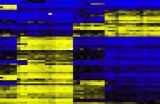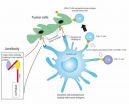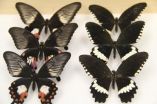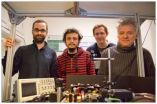(Press-News.org) March 5, 2014, New York, NY– A Ludwig Cancer Research study suggests that the clinical efficacy of checkpoint blockade, a powerful new strategy to harness the immune response to treat cancers, might be dramatically improved if combined with oncolytic virotherapy, an investigational intervention that employs viruses to destroy tumors.
Published today in the journal Science Translational Medicine, the study evaluated a combination therapy in which the Newcastle disease virus (NDV), a bird virus not ordinarily harmful to humans, is injected directly into one of two melanoma tumors implanted in mice, followed by an antibody that essentially releases the brakes on the immune response. The researchers report that the combination induced a potent and systemically effective anti-tumor immune response that destroyed the non-infected tumor as well. Even tumor types that have hitherto proved resistant to checkpoint blockade and other immunotherapeutic strategies were susceptible to this combined therapy.
"Many patients have benefited from cancer immunotherapies," says Dmitriy Zamarin, a member of Ludwig's Collaborative Laboratory at Memorial Sloan Kettering Cancer Center (MSK) and lead author of the study together with James Allison of the MD Anderson Cancer Center in Houston, and Jedd Wolchok, Director of the Ludwig Collaborative Laboratory at MSK. "But they have not been effective for all patients, or against all cancer types, since most cancers can potently suppress immune responses. We want to extend the benefits of immunotherapies to more patients and optimize their use against a larger variety of cancers."
Zamarin and his colleagues found that an inflammatory immune response induced in the tumor by NDV primarily accounts for the efficacy of the therapy. The checkpoint blockade antibody used in this study binds CTLA-4, a molecule found on immune cells that acts like a brake (or "checkpoint") on the immune response. A version of this antibody is already used for cancer therapy, and it has proved potent in a clinical trial evaluating its combination with another immunotherapy as well.
The researchers noticed that when NDV was injected into a tumor implanted in mice, cancer-killing immune cells flooded into that tumor. "But we also found, to our surprise, that a similar infiltration of activated immune cells occurred in a distant tumor, one in which the virus was never detected," says Zamarin.
The researchers show that NDV infection alerts T cells of the immune system to the presence of cancer cells, which otherwise suppress immune surveillance and attack. Subsequent injection of the anti-CTLA-4 antibody dials up the incipient anti-tumor response so dramatically that it overcomes the tumor's immune suppression and destroys both NDV-exposed tumors and unexposed tumors. And the effect appears to be durable. When the same tumors are reintroduced into treated animals, they are swiftly eliminated.
Combining the two therapeutic strategies, Zamarin explains, overcomes the limitations of each. Oncolytic virotherapy has long been hindered by the immune system's tendency to disable systemically introduced viruses long before they can target tumors. The current study circumvented this problem by injecting NDV directly into the tumor.
Checkpoint blockade, meanwhile, has failed against tumors that suppress immune detection and attack. The researchers found that NDV prompted the cells of such tumors to betray themselves to the immune system when they informed it about the virus. As a consequence, the strategy even made colorectal and prostate tumors that were resistant to immunotherapy susceptible to checkpoint blockade.
The team also found that NDV could be used to boost the effects of an investigational immunotherapy known as adoptive T cell transfer, in which T cells are taken from patients, trained to recognize specific tumors and then reintroduced into their bodies. Adoptive transfer too has been hampered by the ability of tumors to suppress immune responses.
Pretreatment with NDV may similarly boost other immunotherapies. Additionally, Zamarin notes, NDV could be engineered to package and express immune factors that might further boost desirable elements of the anti-tumor response. The researchers are now working to expand production of NDV and devise protocols to evaluate their combination therapy in early stage clinical trials.
INFORMATION:
This study was supported with funds from Ludwig Cancer Research, the Howard Hughes Medical Institute, the US National Institutes of Health, Swim Across America, the Danish Cancer Society, the Damon Runyon Cancer Research Foundation and the ASCO Conquer Cancer Foundation.
About Ludwig Cancer Research
Ludwig Cancer Research is an international collaborative network of acclaimed scientists with a 40-year legacy of pioneering cancer discoveries. Ludwig combines basic research with the ability to translate its discoveries and conduct clinical trials to accelerate the development of new cancer diagnostics and therapies. Since 1971, Ludwig has invested more than $2.5 billion in life-changing cancer research through the not-for-profit Ludwig Institute for Cancer Research and the six U.S.-based Ludwig Centers.
Jedd Wolchok is the Director of the Ludwig Collaborative Laboratory at Memorial Sloan Kettering Cancer Center. For more information click here: http://www.ludwigcancerresearch.org/location/ny-collaborative-laboratory
For further information please contact Rachel Steinhardt, rsteinhardt@licr.org or +1-212-450-1582.
Going viral to target tumors
Ludwig researchers show that infecting just 1 tumor with a virus could boost the systemic effectiveness of cancer immunotherapy
2014-03-05
ELSE PRESS RELEASES FROM THIS DATE:
Biomarkers of cell death in Alzheimer's reverse course after symptom onset
2014-03-05
Three promising biomarkers being studied to detect Alzheimer's disease in its early stages appear to undergo a surprising shift as patients develop symptoms of dementia, researchers at Washington University School of Medicine in St. Louis report.
Scientists use the biomarkers to assess brain changes linked to the disease in research volunteers. The levels of markers of neuronal injury increase in the spinal fluid for a decade or more before the onset of dementia, but in a new twist, the research shows for the first time that they later reverse course, decreasing as symptoms ...
An inventive new way to profile immune cells in blood
2014-03-05
ROVIDENCE, R.I. [Brown University] — When a person becomes sick or is exposed to an unwelcome substance, the body mobilizes specific proportions of different immune cells in the blood. Methods of discovering and detecting those profiles are therefore useful both clinically and in research. In a new paper in the journal Genome Biology, a team of scientists describes a new and uniquely advantageous way to detect them.
All the current means of counting immune cells in a blood sample require whole cells, said Karl Kelsey, professor of epidemiology at Brown and corresponding ...
Novel cancer vaccine holds promise against ovarian cancer, mesothelioma
2014-03-05
A novel approach to cancer immunotherapy – strategies designed to induce the immune system to attack cancer cells – may provide a new and cost-effective weapon against some of the most deadly tumors, including ovarian cancer and mesothelioma. Investigators from the Massachusetts General Hospital (MGH) Vaccine and Immunotherapy Center report in the Journal of Hematology & Oncology that a protein engineered to combine a molecule targeting a tumor-cell-surface antigen with another protein that stimulates several immune functions prolonged survival in animal models of both ...
Hungry for 'likes': Frequent Facebook use linked to eating disorder risk, study finds
2014-03-05
TALLAHASSEE, Fla. — Frequent Facebook users might be sharing more than party pictures, vacation videos and shameless selfies — they also share a greater risk of eating disorders, according to a new study led by Florida State University researchers.
Psychology Professor Pamela K. Keel studied 960 college women and found that more time on Facebook was associated with higher levels of disordered eating. Women who placed greater importance on receiving comments and "likes" on their status updates and were more likely to untag photos of themselves and compare their own photos ...
Prenatal nicotine exposure may lead to ADHD in future generations
2014-03-05
TALLAHASSEE, Fla. — Prenatal exposure to nicotine could manifest as attention deficit hyperactivity disorder in children born a generation later, according to a new study by Florida State University College of Medicine researchers.
Professors Pradeep G. Bhide and Jinmin Zhu have found evidence that ADHD associated with nicotine can be passed across generations. In other words, your child's ADHD might be an environmentally induced health condition inherited from your grandmother, who may have smoked cigarettes during pregnancy a long time ago. And the fact that you never ...
A single gene, doublesex, controls wing mimicry in butterflies
2014-03-05
A single gene regulates the complex wing patterns, colors and structures required for mimicry in swallowtail butterflies, report scientists from the University of Chicago, March 5 in Nature. Surprisingly, the gene described, doublesex, is already well-known for its critical role in sexual differentiation in insects.
"Conventional wisdom says that it should be multiple genes working together to control the whole wing pattern of a butterfly," said Marcus Kronforst, Neubauer Family Assistant Professor of Ecology & Evolution at the University of Chicago and senior author ...
Ultra sensitive detection of radio waves with lasers
2014-03-05
Radio waves are used for many measurements and applications, for example, in communication with mobile phones, MRI scans, scientific experiments and cosmic observations. But 'noise' in the detector of the measuring instrument limits how sensitive and precise the measurements can be. Now researchers at the Niels Bohr Institute have developed a new method where they can avoid noise by means of laser light and can therefore achieve extreme precision of measurements. The results are published in the prestigious scientific journal, Nature.
'Noise' in the detector of a measuring ...
Livestock can produce food that is better for the people and the planet
2014-03-05
With one in seven humans undernourished, and with the challenges of population growth and climate change, the need for efficient food production has never been greater. Eight strategies to cut the environmental and economic costs of keeping livestock, such as cows, goats and sheep, while boosting the quantity and quality of the food produced have been outlined by an international team of scientists.
The strategies to make ruminant - cud-chewing - livestock a more sustainable part of the food supply, led by academics at the University of Bristol's School of Veterinary ...
ALS-linked gene causes disease by changing genetic material's shape
2014-03-05
Johns Hopkins researchers say they have found one way that a recently discovered genetic mutation might cause two nasty nervous system diseases. While the affected gene may build up toxic RNA and not make enough protein, the researchers report, the root of the problem seems to be snarls of defective genetic material created at the mutation site.
The research team, led by Jiou Wang, Ph.D., an assistant professor of biochemistry and molecular biology and neuroscience at the Johns Hopkins University School of Medicine, reports its finding March 5 on the journal Nature's ...
Study aims to define risk factors for falls in post-menopausal women
2014-03-05
ROSEMONT, Ill.–A new study appearing in the March issue of the Journal of Bone and Joint Surgery (JBJS) showed that women with distal radius (wrist) fractures had decreased strength compared to similar patients without fractures. This could explain why these women were more likely to fall and might sustain future fractures.
The investigators used a variety of balance and strength tests combined with patient-provided information about walking habits to evaluate the physical performance and risk of falls for post-menopausal women with and without previous wrist fractures. ...
LAST 30 PRESS RELEASES:
Injectable breast ‘implant’ offers alternative to traditional surgeries
Neuroscientists devise formulas to measure multilingualism
New prostate cancer trial seeks to reduce toxicity without sacrificing efficacy
Geometry shapes life
A CRISPR screen reveals many previously unrecognized genes required for brain development and a new neurodevelopmental disorder
Hot flush treatment has anti-breast cancer activity, study finds
Securing AI systems against growing cybersecurity threats
Longest observation of an active solar region
Why nail-biting, procrastination and other self-sabotaging behaviors are rooted in survival instincts
Regional variations in mechanical properties of porcine leptomeninges
Artificial empathy in therapy and healthcare: advancements in interpersonal interaction technologies
Why some brains switch gears more efficiently than others
UVA’s Jundong Li wins ICDM’S 2025 Tao Li Award for data mining, machine learning
UVA’s low-power, high-performance computer power player Mircea Stan earns National Academy of Inventors fellowship
Not playing by the rules: USU researcher explores filamentous algae dynamics in rivers
Do our body clocks influence our risk of dementia?
Anthropologists offer new evidence of bipedalism in long-debated fossil discovery
Safer receipt paper from wood
Dosage-sensitive genes suggest no whole-genome duplications in ancestral angiosperm
First ancient human herpesvirus genomes document their deep history with humans
Why Some Bacteria Survive Antibiotics and How to Stop Them - New study reveals that bacteria can survive antibiotic treatment through two fundamentally different “shutdown modes”
UCLA study links scar healing to dangerous placenta condition
CHANGE-seq-BE finds off-target changes in the genome from base editors
The Journal of Nuclear Medicine Ahead-of-Print Tip Sheet: January 2, 2026
Delayed or absent first dose of measles, mumps, and rubella vaccination
Trends in US preterm birth rates by household income and race and ethnicity
Study identifies potential biomarker linked to progression and brain inflammation in multiple sclerosis
Many mothers in Norway do not show up for postnatal check-ups
Researchers want to find out why quick clay is so unstable
Superradiant spins show teamwork at the quantum scale
[Press-News.org] Going viral to target tumorsLudwig researchers show that infecting just 1 tumor with a virus could boost the systemic effectiveness of cancer immunotherapy




